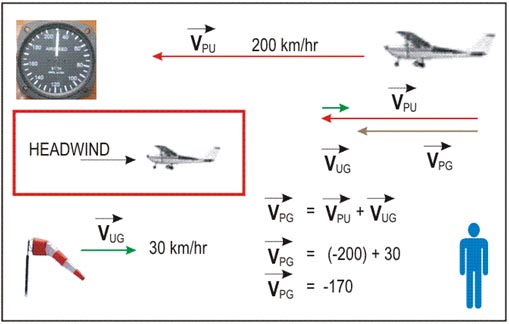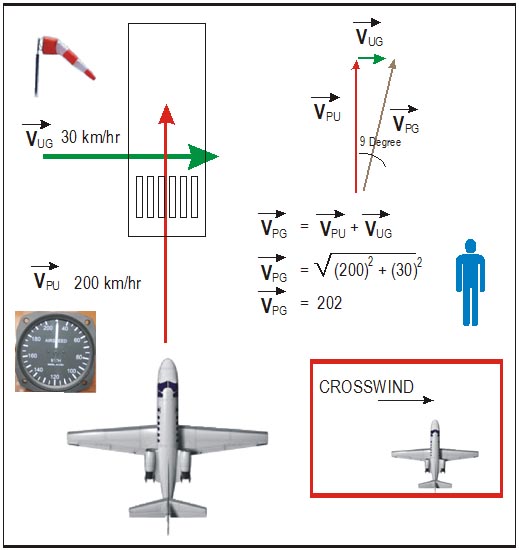 Download Tutorial Lengkap (PDF 889 KB)
Download Tutorial Lengkap (PDF 889 KB)
WIND AND ITS EFFECT TO THE AIRPLANE
1. FLY BY THE WIND
On the previous chapter described the air moving across the airplane or air is stay and the aircraft moving thorugh the air. The real condition of air in the atmosphere is never stay in a place, but always moving from one place to another creating a wind.
Wind described as moving air from a place which has a high air pressure to a place with low air pressure. Since the air it self is moving of course it will have effect to the airplane which fly through it. Sometime create advantage to the airplane while others creating disadvantage. For instance a Sail Plane aircraft is flying using advantage of moving air rising called thermal up drift.

1.1 Wind and its nature
Wind or moving air is created by the nature. By description, wind is moving air between a place which has high pressure air to a place with low pressure. High or low pressure is impact of the solar radiation to the earth. Some place received high solar radiation hence air pressure is lower than other which received low solar radiaton. This deferences creating a wind blows.

In a place (usually a land) if received high solar radiation, it will have an impact in air temperature. The air over this land will have air temperature increased. As the temperature increased, the air pressure will decreased. The air will be pushed upward. This phenomena is called Thermal Up Drift.
The air then pushed to somewhere else, colling and decreasing. This place is mostly cloudy place or have lower solar radiation or higher water intensity (can be in the sea). The air then will have lower temperature and as the temperature drop, the air pressure will be increased.
As the place have higher air pressure, the air the moved leaving this place and go to the lower air pressure, i.e. the first place which has higher solar radiation. This phenomena called wind cycle
1.2 Wind Measurements
As the aircaft behaviour is due to moving air through its wing, we need to measure the wind condition most of the time i.e. before take off, while aircraft fly in air and also when landing.

Two parameters of wind we need to measure, i.e:
Wind Directions Pilot need to know wind directions as the lift is created when the air is moving through the wing. Pilot need as much as possible to direct the aircraft head wind. If not possible, Pilot should counter this wind directions.
Wind Speed Pilot need to know the wind speed as this creating lift force, drag and also relative movement. Higher wind speed or lower wind speed should be anticipated at once since the Force Balance should be impacted by the wind speed.
1.3 Relative Speed
Relative movements first time introduce by Einstein. This phenomena can be explained by a man moving in a moving train, seen by other people on the ground. There are two movement i.e. a man moving relative to the train and the train moving relative to the ground. These movement creating a vector and the speed of these movement will be also the resultant speed.

The Resultant vector will be :

This relative movements phenomena is happened also in the aircraft fly in the air. Pilot will have measurement of the air speed VPU, i.e. the speed or the aircraft moving relative to the air surroundings. If the air is moving VUG relatively to the ground. Hence a people on the ground see the aircraft speed as the following

1.4 Directions in Flight
Directions in flight is mentioned using 3 (three) digit notations. This 3 digit notation is the degree direction of flight. For instance, instead of mentioning “the aircraft fly to north east”, it is mentioned : “the aircraft fly to 045”.
Runway number is also using this 3 digit notation but shorted to 2 digit. For instance runway # 29 will have take off headed to 290 degree directions.

1.5 Wind Directions during Take Off and Landing
Wind directions has a biggest impact when aircraft take off and or landing. All Pilot should take precautions of the wind directions during landing (and take off). Taking a wrong actions may be impacted in aircraft slip out of runway during landing touch down due to air drift especially when Pilot should face cross wind.
Most of air traffic control will turn the airport to have the airplane land using the best suite to the wind directions. But sometime the wind directions is change suddently and air traffic control does not have chance to turn the airport yet, the Pilot should face this and do the best to land the airplane safely.
Headwind Landing
Headwind Landing is landing (or take off) with wind come from upfront of the aircraft facing the runway. Headwind landing reduces the landing distance for an aircraft. Landing into a headwind reduces the Ground Speed. This is beneficial to both, the pilots as well as the Air traffic controllers (ATC).
An aircraft landing into a headwind will require lesser runway and will be able to vacate the runway sooner. If the headwind decreases near the ground, theres a decrease in the performance of the aircraft and it will tend to sink and possibly under shoot the aiming point.

Tailwind Landing
Tailwind Landing is landing (or take off) with wind come from back of the aircraft facing the runway. Tailwind increases the Ground Speed of an aircraft and thus a longer runway distance will be required for an aircraft to land. Climb angle is also reduced. A five knot tailwind increase take-off distance with 25% and a ten knot tailwind with about 55%.
Landing in a tailwind situation could lead to a stall because of the tendency of the pilot to reduce the airspeed while landing, as the Pilot know the tailwind is pushing aircraft faster. Also, theres a chance of over shooting the runway and colliding with objects or terrain.

Cross Wind Landing
Crosswind Landing is landing (or take off) with wind come with direction of perpendicular to the runway. This is rare situation as the Air Traffic Control (ATC) should turn the runway immediately. But in actual situation, wind may suddently change directions.
Landing in a crosswind situation could lead to side slip as the wind with cross direction will push the aircraft slip to side of the runway. Pilot should anticipate by deploying several landing technique suitable to the aircraft.

Cross Wind and Side Slip Landing
This sideslip crosswind technique is to maintain the aircrafts heading aligned with the runway centerline. The initial phase of the approach is flown using the Crab technique to correct for drift. The aircraft heading is adjusted using rudder and ailerons to align with the runway. This places the aircraft at a constant sideslip angle, which its natural stability will tend to correct. Sufficient rudder and aileron must be applied continuously to maintain the sideslip at this value. The dihedral action of the wings has a tendency to cause the aircraft to roll, so aileron must be applied to check the bank angle.

With a slight residual bank angle, a touchdown is typically accomplished with the upwind main wheels touching down just before the downwind wheels. Excessive control must be avoided because over-banking could cause the engine nacelle or outboard wing flap to contact the runway/ground.

Selamat Terbang...